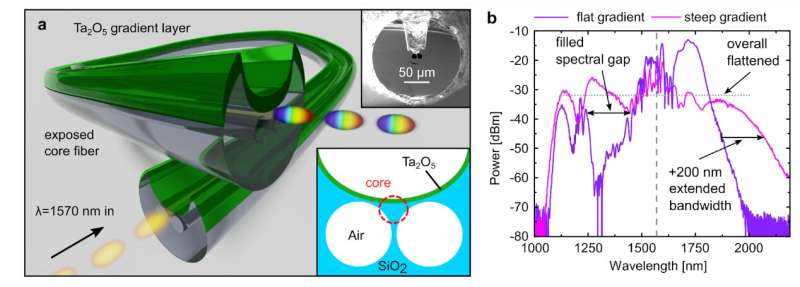Flattening the curve: Nano-film enhanced supercontinuum edition

Providing light with tailored properties through ultrafast supercontinuum generation represents an active field of nonlinear science research. A German-Australian research collaboration has presented a new concept that includes a longitudinally varying thickness nano-films in microstructured exposed core fibers. This offers low input energy, broadband and spectrally flattened spectra in the near infrared with high pulse-to-pulse stability, establishing a novel class of light sources for fields such as biophotonics, medical diagnostics, environmental sciences, or metrology.
Spectral light sources are one of the principal basic modules of all rising modern optical technology. High demands are set by various applications in medical diagnostics, fundamental science and environmental screening with individually different requirements in terms of spectral range and uniformity, intensity and stability. For instance, optical coherence tomography needs a flat spectrum to ensure high-resolution scans of the human retina. Furthermore, field application hand-held spectroscopy favors lightweight solutions with limited energy supply. With fiber-based supercontinuum sources being a promising technology to create broadband light from a single laser, detailed investigation and optimization of this nonlinear frequency conversion process with unconventional methods is necessary.
Scientists from the Leibniz Institute of Photonic Technology (Leibniz IPHT) in Jena, Germany, led by Professor Markus A. Schmidt in a collaboration with the University of Adelaide, Adelaide, Australia, present a novel concept to improve supercontinuum light sources in a new paper published in Light Advanced Manufacturing. The key of their work is incorporating precisely deposited nano-films inside microstructured fibers. Nano-films can be added via sputtering through an open channel in the fiber directly on the optical core.
"Having the freedom to arbitrarily tailor the nano-film thickness along the whole fiber length leads to interesting physics," the authors claim. "Especially thickness increasing nano-film gradients by tilting the fiber in the deposition chamber has proven to be useful." These gradients change the nonlinear frequency conversion condition at different positions in the fiber to create light at many different wavelengths and fill up a broad and flattened output spectrum. This allows for the creation of broad and flat spectra at low input energy.
The scientists comment, "Low input energy in combination with avoiding higher-order soliton fission and modulation instability ensures high coherence and an excellent pulse to pulse stability, which, for example, is relevant for optical frequency metrology." On top of it, the bandwidth is extended towards the infrared compared to constant thickness nano-film enhanced fibers. "It is like the Raman shifting soliton surfing on the wave of changing dispersion towards longer wavelengths," they vividly explain.
Their generic concept of including longitudinally varying optical resonances into waveguides is not limited to fibers and can be flexibly used with a range of high index materials such as metal oxides, chalcogenides and semiconductors. "This shifts the production challenge for new tailored light sources from drawing precise fibers to depositing layers, which is more widely available around the world," they add.
More information: Tilman A. K. Lühder et al, Longitudinally thickness-controlled nanofilms on exposed core fibres enabling spectrally flattened supercontinuum generation, Light: Advanced Manufacturing (2021). DOI: 10.37188/lam.2021.021
Provided by Chinese Academy of Sciences




















